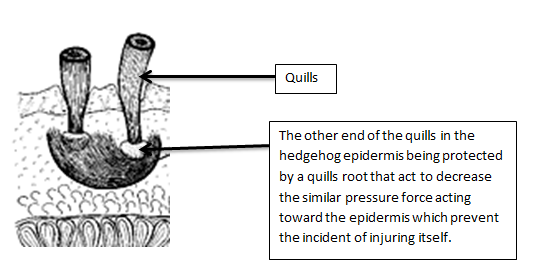Hedgehog quilling is the physiological process of a hedgehog shedding its spines i.e. exchanging new spines to replace the old ones.
Contents
Spines are like extra hard hair
These subcutaneous, keratinous extensions are really extra hard hairs for hedgehogs.

The shape of the quill has a tapering at each end, converging to a point a sharp point.
Although, the end of the spine which is anchored in the hedgehog skin is held in a protective casing at the root, preventive self-injury if pressure is applied.
Just like our own hair, if a spine falls out, it is replaced by another that grows back in its place.
The structure of the spine is hollow – a bit like a feather’s quill, yet the end had tiny barbs.
Unlike porcupines which can shoot out their spines, hedgehogs are only able to release the gentle – although, they are readily able to perform this protective measure.
Quilling occurs at regular intervals in a hedgehog’s life
At certain times in the life of a hedgehog, they shed large portions of their spines at a single period of about a week or two.
The first instance of quilling will be when the hedgehog is at about 6-8 weeks old, then again at 4 months – and then, at set intervals.
Is quilling uncomfortable for a hedgehog?
Yes – quilling can make the skin of the hedgehog very sore.
This is because (again – much like our hair) each spine is rooted within a pore or natural opening in the skin of the hedgehog.
The size of pore is relative to the thickness of the spine shaft (width of the spine).
With younger hedgehogs, the spine is relatively thin in comparison to older hedgehogs.
This means that when the new ‘thicker’ quill replaces the old ‘thinner’ quill, the pore size adjusts by rapidly stretching the surrounding skin out of shape.
This can produce quite an uncomfortable feeling for the hedgehog, which will experience considerable soreness at the time.
Can spines become ingrown?
Yes – hedgehog spines can get ingrown.
This is when a new spine or spike which is growing out of the skin fails to break clear of the skin surface and coils back on itself under the skin.
This leaves a sore red swelling beneath the pore within the skin layers and can even lead to severe inflammation and/or bacterial infection at the site of the spine.
A recommended treatment for ingrown spines is the use of tweezers to delicately pluck out the spine from under the skin to release it. Also, cleansing the skin with a bit of antiseptic rub.
Also, in the interest of avoiding or minimising further incidence of ingrown spines, it is recommended that if you are dealing with a domesticated hedgehog, that you bathe them with oatmeal shampoo like, Aveeno.
The oatmeal in the shampoo has an exfoliating action which lift out by agitation any spines that would potentially get stuck under the skin.
Are there other reasons why a hedgehog might suddenly lose most of its spikes?
Yes – most commonly an infestation of mites or ticks can have a subsequent effect of many spines being lost at once.
Also, if the hedgehog’s diet is poor, they can lack the necessary nutritional supply to produce more spines, or to keep current spines healthy. They can therefore drop out of the skin, leaving the hedgehog bald in parts.
Finally, stress can trigger the loss of spines in a hedgehog.
But if you have any worries, then contact the local rescue centre.
Do you have any experience of seeing quilling or caring for a hedgehog going through it?
Join the conversation below.
References:
Reddit – Hedgehog Forum on Quilling
http://hedgehogheadquarters.com/secure/characteristics.htm
http://hedgehogheadquarters.com/secure/quilling.htm